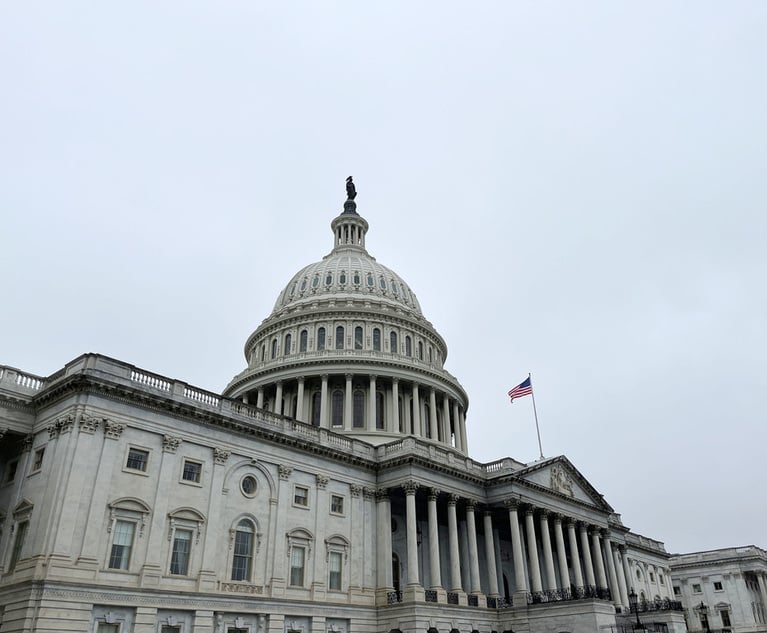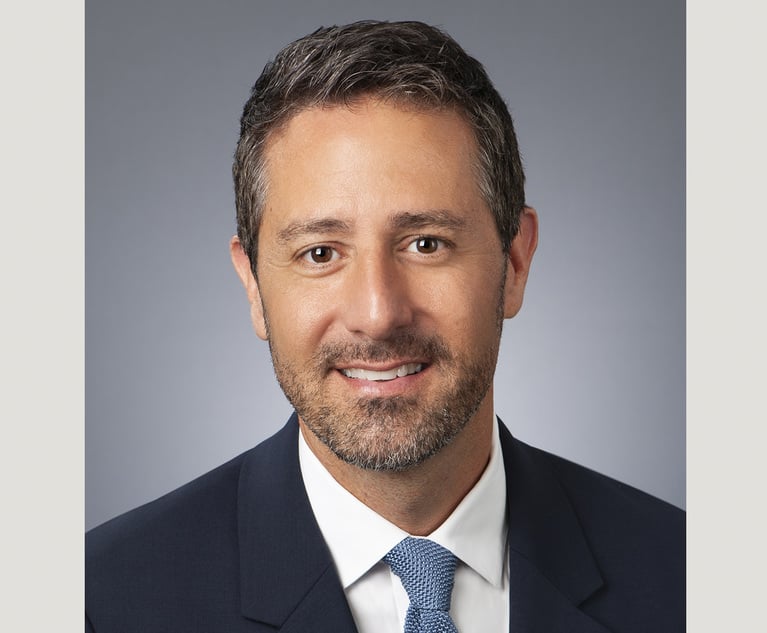Law Firm Margins Tighten as First-Half Expenses Outgrow Revenue
Revenue grew 4.1% in the first half, but expenses grew 5.9%, Citi Private Bank's Law Firm Group reports.
August 20, 2019 at 05:30 AM
7 minute read
 Credit: Shutterstock.com
Credit: Shutterstock.com
We saw improvement, albeit modest, in industry performance from the first-quarter results to the first half of 2019, but so far it’s a different year than last year. With marginal demand growth and a continued lengthening of the collection cycle, 2019 has reverted to a rate story. Meanwhile, expenses have continued to grow at a faster pace than revenue, placing pressure on margins. Looking ahead, the back half of the year should benefit from strong inventory balances at the midyear point. It will be a challenge for the industry to see a repeat of 2018’s strong performance in this year’s results, but expect it to be a good year relative to earlier post-recession years.
These results are based on a sample of 191 firms (77 Am Law 100 firms, 54 Second Hundred firms and 60 niche/boutique firms). Thirty-six of these firms fit our definition of either international (less than 25% but more than 10% of lawyers based outside the United States) or global (at least 25% of lawyers based outside the United States). Citi Private Bank provides financial services to more than 700 U.S. and U.K. law firms and more than 50,000 individual lawyers. Each quarter, the Law Firm Group confidentially surveys firms in the Am Law 100 and the Second Hundred, along with smaller firms. In addition, we conduct a more detailed annual survey and semiannually produce the Law Firm Leaders Confidence Index. These reports, together with extensive discussions with law firm leaders, provide a comprehensive overview of current financial trends in the industry as well as forward-looking insight.
Revenue growth of 4.1% in the first half of 2019 was driven largely by lawyer billing rate growth of 4.6%, as demand grew 0.1%. While marginal demand growth is a very different story than in the first half of 2018, many firms told us that activity improved during the second quarter, and indeed we saw an improvement over the first quarter demand decline of 0.3%. If soft demand has tempered revenue growth, so has the 1.6% lengthening of the collection cycle—up from the 1% lengthening reported in the first quarter, and continuing a prolonged trend. We continue to hear from firms about the shift in client bill payment behavior driving much of the collections slowdown, citing e-billing systems and greater scrutiny around bill review. Some firms talk of their clients unilaterally changing payment terms as a primary driver of the longer collection cycle. The good news is that inventory growth remained relatively strong at 5.8% and should continue to provide collections momentum into the third quarter.
Expense growth of 5.9% moderated from the 6.5% reported in the first quarter. However, it significantly exceeded revenue growth, compressing margins. Lawyer compensation growth of 7.3% continued to drive much of the increase in expenses, and was driven in part by lawyer head count growth of 1.7%. The greater pressure comes from the mid-2018 associate compensation increases, which are now mostly priced into the expense base. Operating expenses were up 4.8%, but have moderated since the material first quarter 5.9% increase, helping to manage the total expense growth result.
With 1.7% growth in total lawyer head count, and just 0.1% increase in the equity partnership, lawyer leverage was up by 2.1%. Meanwhile, given the modest demand environment, we saw average lawyer productivity continue to trail 2018 results, dipping 1.2%. While this is better than the 1.8% productivity decline we saw during the first quarter, we continue to operate in an environment where firms are paying more for lower productivity.
Behind these averages, we saw a return to high levels of dispersion in demand performance. Fifty percent of firms saw demand decline during the first half of 2019—the highest proportion for a first half since 2014. We also saw volatility in demand performance, defined as alternating periods of demand growth and decline. To measure volatility, we looked at the 151 firms that reported first-half results in 2017, 2018 and 2019. Notably, approximately 51% of these firms either saw demand increase in the first half of 2018 and decrease in the first half of 2019, or vice versa. Further, roughly 28% of firms saw demand decline in both periods.
Looking at the results by revenue size, Am Law 51-100 firms continued to outperform other segments in revenue and demand growth, up 5.1% and 1%, respectively. While the collection cycle lengthened for these firms, Am Law 51-100 firms also have the highest inventory growth (at 7.4%), setting them up well for a strong third quarter. In contrast, Am Law 1-50 firms saw flat demand growth, but recovered from the 0.7% decline we saw during the first quarter. Am Law 1-50 rate increases continued to outpace other segments, up 5.2%, and were the primary driver of the 4.2% growth in revenue (second only to the Am Law 51-100 firms). Am Law 1-50 firms also saw the collection cycle lengthen by 1.8% and carry strong inventory levels (up 6.1%) into the rest of the year.
The smaller firms in our sample (Second Hundred firms and Other firms) had a challenging first half of the year. Both segments were well below the industry averages in terms of revenue growth (both up 2.8%) and lawyer billing rate growth (3.4% and 2.8%, respectively). Second Hundred firms saw demand grow 0.4% while Other firms saw a material decline of 2.6%. Compared to Am Law 100 firms, both of these segments have comparatively lower inventory growth going into the rest of the year.
Looking at firms by geographic reach, global firms saw the greatest demand growth (1.5%) and saw the second-strongest increases in both revenue (up 4.1%) and billing rates (up 4.7%). They also carry a 6.6% inventory increase into the third quarter, signaling strong collections ahead. International firms saw the greatest rate increases, at 5.7%, but demand was down 0.9% and the collection cycle lengthened by 2.7%. As a result, this segment reported 3.8% growth in revenue. Looking ahead, with 6.5% inventory buildup, international firms should also see a strong second half. With both segments experiencing margin pressure, and possible currency headwinds, collections will be an imperative during the second half of this year.
National firms saw the greatest revenue growth (5.4%), driven by a combination of 0.8% demand growth, 4.3% rate increases and a shortened collection cycle. Indeed, this was the only segment to shorten the collection cycle. Meanwhile, inventory growth of 5% should help boost second-half collections.
Regional firms saw the most challenging first half. They reported the largest demand decline at 1.3% and the lowest billing rate increase of 3.9%. Revenue growth of 2.6% trailed all segments, far below the 4.5% growth in expenses. Looking ahead, 5.2% growth in inventory places these firms in a decent position for collections.
The first half of 2019 saw slower revenue growth than we saw through the same period in 2018. While the demand environment improved from first to second quarter, demand for the first six months remained essentially flat compared with the first half of 2018, with a return to high levels of dispersion. Meanwhile, the collection cycle continues to lengthen, making strong billing rate increases the primary driver of top-line growth. Looking to the second half of 2019, collecting on increased inventory levels will be key—especially given the margin pressure we see in first-half results. We expect 2019 to be a decent year. However, as we wrote in May, it will be challenging to build on the success of 2018, and many firms will fall short of that goal, possibly driving continued market consolidation.
Gretta Rusanow is head of advisory services within Citi Private Bank’s Law Firm Group. Jeff Grossman is head of business development and client strategy. Client adviser David Altuna contributed to this article.
This content has been archived. It is available through our partners, LexisNexis® and Bloomberg Law.
To view this content, please continue to their sites.
Not a Lexis Subscriber?
Subscribe Now
Not a Bloomberg Law Subscriber?
Subscribe Now
NOT FOR REPRINT
© 2025 ALM Global, LLC, All Rights Reserved. Request academic re-use from www.copyright.com. All other uses, submit a request to [email protected]. For more information visit Asset & Logo Licensing.
You Might Like
View All
'Ridiculously Busy': Several Law Firms Position Themselves as Go-To Experts on Trump’s Executive Orders
5 minute read
Holland & Knight Hires Former Davis Wright Tremaine Managing Partner in Seattle
3 minute read
Am Law 200 Firms Announce Wave of D.C. Hires in White-Collar, Antitrust, Litigation Practices
3 minute read
Paul Hastings Hires Music Industry Practice Chair From Willkie in Los Angeles
Trending Stories
- 15th Circuit Considers Challenge to Louisiana's Ten Commandments Law
- 2Crocs Accused of Padding Revenue With Channel-Stuffing HEYDUDE Shoes
- 3E-discovery Practitioners Are Racing to Adapt to Social Media’s Evolving Landscape
- 4The Law Firm Disrupted: For Office Policies, Big Law Has Its Ear to the Market, Not to Trump
- 5FTC Finalizes Child Online Privacy Rule Updates, But Ferguson Eyes Further Changes
Who Got The Work
J. Brugh Lower of Gibbons has entered an appearance for industrial equipment supplier Devco Corporation in a pending trademark infringement lawsuit. The suit, accusing the defendant of selling knock-off Graco products, was filed Dec. 18 in New Jersey District Court by Rivkin Radler on behalf of Graco Inc. and Graco Minnesota. The case, assigned to U.S. District Judge Zahid N. Quraishi, is 3:24-cv-11294, Graco Inc. et al v. Devco Corporation.
Who Got The Work
Rebecca Maller-Stein and Kent A. Yalowitz of Arnold & Porter Kaye Scholer have entered their appearances for Hanaco Venture Capital and its executives, Lior Prosor and David Frankel, in a pending securities lawsuit. The action, filed on Dec. 24 in New York Southern District Court by Zell, Aron & Co. on behalf of Goldeneye Advisors, accuses the defendants of negligently and fraudulently managing the plaintiff's $1 million investment. The case, assigned to U.S. District Judge Vernon S. Broderick, is 1:24-cv-09918, Goldeneye Advisors, LLC v. Hanaco Venture Capital, Ltd. et al.
Who Got The Work
Attorneys from A&O Shearman has stepped in as defense counsel for Toronto-Dominion Bank and other defendants in a pending securities class action. The suit, filed Dec. 11 in New York Southern District Court by Bleichmar Fonti & Auld, accuses the defendants of concealing the bank's 'pervasive' deficiencies in regards to its compliance with the Bank Secrecy Act and the quality of its anti-money laundering controls. The case, assigned to U.S. District Judge Arun Subramanian, is 1:24-cv-09445, Gonzalez v. The Toronto-Dominion Bank et al.
Who Got The Work
Crown Castle International, a Pennsylvania company providing shared communications infrastructure, has turned to Luke D. Wolf of Gordon Rees Scully Mansukhani to fend off a pending breach-of-contract lawsuit. The court action, filed Nov. 25 in Michigan Eastern District Court by Hooper Hathaway PC on behalf of The Town Residences LLC, accuses Crown Castle of failing to transfer approximately $30,000 in utility payments from T-Mobile in breach of a roof-top lease and assignment agreement. The case, assigned to U.S. District Judge Susan K. Declercq, is 2:24-cv-13131, The Town Residences LLC v. T-Mobile US, Inc. et al.
Who Got The Work
Wilfred P. Coronato and Daniel M. Schwartz of McCarter & English have stepped in as defense counsel to Electrolux Home Products Inc. in a pending product liability lawsuit. The court action, filed Nov. 26 in New York Eastern District Court by Poulos Lopiccolo PC and Nagel Rice LLP on behalf of David Stern, alleges that the defendant's refrigerators’ drawers and shelving repeatedly break and fall apart within months after purchase. The case, assigned to U.S. District Judge Joan M. Azrack, is 2:24-cv-08204, Stern v. Electrolux Home Products, Inc.
Featured Firms
Law Offices of Gary Martin Hays & Associates, P.C.
(470) 294-1674
Law Offices of Mark E. Salomone
(857) 444-6468
Smith & Hassler
(713) 739-1250










